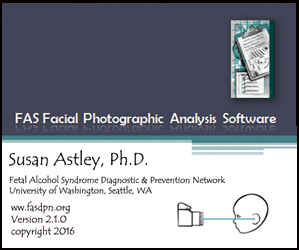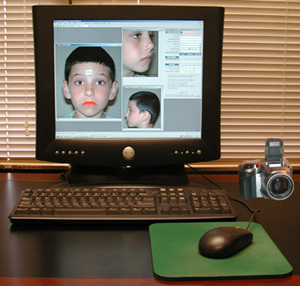
The FAS Facial Photographic Analysis software was developed by Susan (Astley) Hemingway PhD in 2003 (and updated in 2012 and 2016) for use by health care and research professionals. It has been used to accurately measure the full continuum of expression of the FAS facial phenotype as defined by the FASD 4-Digit Code in thousands of individuals, birth to adult, evaluated in the FASD screening and diagnostic programs conducted by the Washington State FAS Diagnostic & Prevention Net (Astley & Clarren, 2001; Astley et al., 2002; Astley 2004). Analysis of over 3,000 patients has confirmed that the software provides more accurate measures of facial features than direct measurement by hand. The ability of the software to measure palpebral fissure lengths more accurately than can be achieved with a hand held ruler is summarized in a recent publication (Astley, 2015). Over 3,000 copies of the software have been distributed across 35 countries to date.
|
|
 |
 |
Brief Description of the Software To use the software, the User:
From this information, the software automatically computes the FASD 4-Digit Code Facial ABC-Score, and the 4-Digit Facial Rank.
The software stores all photo analysis information in a database that can be exported to Excel. The User can print a one-page FAS Facial Photographic Analysis Report. The report includes a summary of the facial analysis and a print of the three photos. A facial photographic analysis can be conducted in approximately 10 minutes. What's New with Version 2.0 (released November 2012) (No longer distributed) Version 2.0 provided the following new features:
What's New with Version 2.1 (released September 2016) Most current version distributed. Version 2.1 has the same features as Version 2.0, but now has the new Lip-Philtrum Guides with the frontal and 3/4 view images. Video Introduction to the Software Software Manual Accuracy of the Software: Palpebral Fissure Length How to Take the Facial Photographs Important Note: Digital cameras (including iPhones) are prone to taking distorted photos if the camera is held too close to the subject's face. It is imperative that the camera be held at least 4 feet from the subject's face to avoid distortion. The distortion will result in inaccurate facial measurements. Read this document to learn how to recognize and avoid taking distorted photos. To Order the Software Software Installation Instructions |
|













